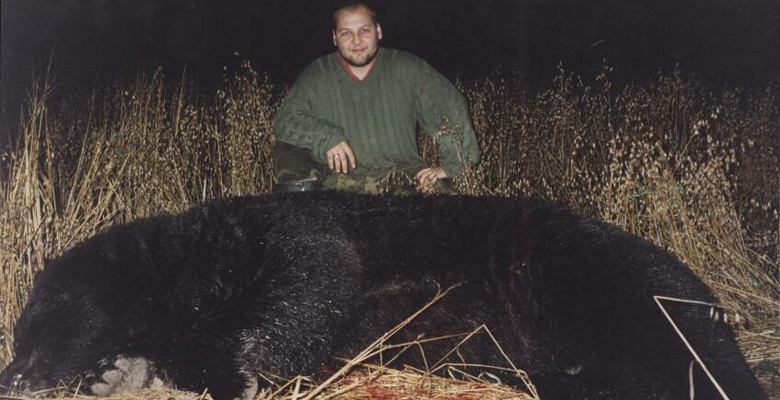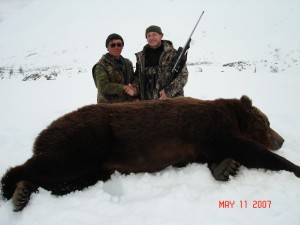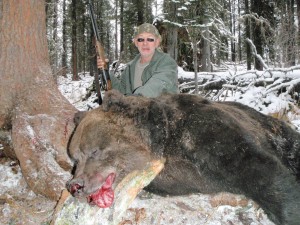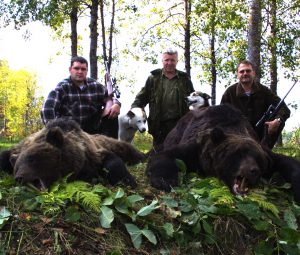Brown Bear Hunting in Russia
General information
Brown bear hunting is available almost anywhere in Russia, but it is especially good in the Kamchatka peninsula, European Northwest, and along the sea of Okhotsk shore. The population of brown bears there has been stable for many years and, according to estimates, currently sits in the region of 150,000. This is more than in all other countries in the world combined. The Russian brown bear habitat runs uninterrupted for a distance of 10,000 km (6,000 mi.), from the Finnish border in the west to the Pacific Ocean in the east.
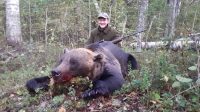
Location: St. Petersburg, Karelia, 200-700 miles E or NE from St. Petersburg
Season dates: August 20-September 30
Hunting method: From the high stand, over oat field, or meat bait
Accommodations: Fully equipped hunting lodge or remote log cabin
Price: St. Petersburg $6350/Karelia $6650 for 2-3 hunters; St. Petersburg $6750/Karelia $7050 solo
An additional day of hunting: $400
Additional trophies: second bear $3000, moose $2500, wolverine $1500
Included in the price:
Reception and assistance in St. Petersburg airport; Accommodation in the hunting area; Meals and soft drinks during the hunt; Roundtrip ground transportation airport-hunting area and
transportation during the hunt; Services of 1 guide per hunter; Services of 1 interpreter in a camp; Field trophy preparation; Gun permit; Invitation letter and voucher; Hunting license; Trophy export permit; 1 bear.
Not included in the price:
Insurance of any kind; International and domestic travel before and after the hunt; Preparation, shipping, or transporting of trophies from Russia; CITES permit: Cost of sightseeing tours; Ground transportation unrelated to hunting; Gratuities.
Itinerary:
Day 1: arrival to St. Petersburg and transfer to the hunting lodge.
Day 2-8: 7 days of hunting
Day 9: return to St. Petersburg for a flight home.
Details:
These are some of the best hunts in the European part of Russia. The bear population during the past 20 years has been very stable. The usual trophy size is about 7 ft., although 8 – 8.5 ft. bears have been taken by our clients every year. The record bear taken in the Pskov region in 1999 had a scull measured in excess of 27 inches (69 cm) The success rate is about 90%. Some hunters take more than one bear.
The weather is usually mild and can be rainy. Moose hunt can be added from September 5 and wolverine can be added from September 15. Bating, by meat in the northern part of Karelia makes this hunt suitable for a bow. Baiting by planted oats is used in the areas closer to St. Petersburg. Each additional trophy requires 3 extra days of hunting.
Request information

Location: Tigilsky district, Kamchatka peninsula
Season dates: April 22 – May 25
Hunting method: Spot and stalk from snowmobiles
Accommodations: Remote cabin with an electric generator, satellite phone, sauna
Price: $12,000
Included in the price:
Reception and assistance in Petropavlovsk airport; Accommodation in the hunting area; Meals and soft drinks during the hunt; Transportation during the hunt; Services of 1 guide per hunter; Services of 1 interpreter in a camp; Field trophy preparation; Gun permit; Invitation letter and voucher; Hunting license; Trophy export permit; 1 bear.
Not included in the price:
Insurance of any kind; International and domestic airfare; Hotel in Petropavlovsk before or after the hunt; Preparation and shipping trophies from Russia; CITES permit; Cost of sightseeing tours; Gratuities.
Itinerary
Day 1: arrival to Petropavlovsk, overnight in Petropavlovsk.
Day 2: flight to Palana village, Tigilsky district, transportation to the hunting cabin
Day 3-9: 7 days of hunting
Day 10: return flight to Petropavlovsk, overnight in Petropavlovsk
Day 11: flight home
Details:
Kamchatka peninsula has the largest population of big salmon-eating bears and currently holds the world record. The average trophy size taken during the spring season is over 9 ft. square. Spring hunts take place when bears emerge from hibernation, with the snow is still present on the ground, which aids in locating the best trophies. The daytime temperature range is from -10 C to +5C in the spring (+20F to +40F). The shooting distance is within 200 yards. Hunters should bring white camo suites, warm clothes, sunglasses, and sleeping bags.
Request information
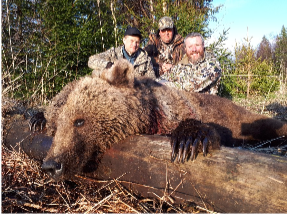
Location: Karelia, 500-700 miles NE from St. Petersburg
Season dates: May 10-Мay 25
Hunting method: From the high stand, over meat bait
Accommodations: Fully equipped hunting lodge or remote log cabin
Price: St. Petersburg $6350/Karelia $6650 for 2-3 hunters; St. Petersburg $6750/Karelia $7050 solo
An additional day of hunting: $400
Additional trophies: capercaillie $350
Included in the price:
Reception and assistance in St. Petersburg airport; Accommodation in the hunting area; Meals and soft drinks during the hunt; Roundtrip ground transportation airport-hunting area and transportation during the hunt; Services of 1 guide per hunter; Services of 1 interpreter in a camp; Field trophy preparation; Gun permit; Invitation letter and voucher; Hunting license; Trophy export permit; CITES permit; 1 bear.
Not included in the price:
Insurance of any kind; International and domestic travel before and after the hunt; Preserving, shipping, or transporting trophies from Russia; Cost of sightseeing tours; Ground transportation unrelated to hunting; Gratuities.
Itinerary:
Day 1: arrival to St. Petersburg and transfer to the hunting lodge.
Day 2-8: 7 days of hunting
Day 9: return to St. Petersburg for a flight home.
Details:
These are some of the best hunts in the European part of Russia. The bear population during the past 30 years has been very stable. The usual trophy size is about 7 ft. square, although 8 – 8.5 ft. bears have been taken by our clients every year. The record bear taken in the Pskov region in 1999 had a scull measured in excess of 27 inches (69 cm) The success rate is about 90%. The weather is usually cool and dry, with melted snow, water on the ground. Capercaillie hunt can be added if the season is still opened. Stands can be placed within 30 to 40 yards from the bate, making this hunt suitable for a bow.
Request information

Location: Ust-Kamchatsky district, Kamchatka peninsula
Season dates: August 25 – October 10
Hunting method: Spot and stalk
Accommodations: Remote cabin with an electric generator, satellite phone, hot shower, sauna
Price: $13,700
Included in the price:
Reception and assistance in Petropavlovsk airport; Accommodation in the hunting area; Meals and soft drinks during the hunt; Round trip bus transfer and helicopter flight; Services of 1 guide per hunter; Services of 1 interpreter in a camp; Field trophy preparation; Gun permit; Invitation letter and voucher; Hunting license; Trophy export permit; 1 bear.
Not included in the price:
Insurance of any kind; International and domestic airfare; Hotel in Petropavlovsk before or after the hunt; Conservation and shipping trophies from Russia; CITES permit; Cost of sightseeing tours; Gratuities.
Itinerary:
Day 1: arrival to Petropavlovsk, 7-hour drive to Maiskoe, overnight in Maiskoe.
Day 2: 55 minute helicopter flight to hunting camp
Day 3-12: 10 days of hunting
Day 13: return to Petropavlovsk, overnight in Petropavlovsk
Day 14: flight home
Details:
Kamchatka peninsula has the largest population of big salmon-eating bears and currently holds the world record. The camp is located south of 15,000 ft. Kamen volcano, and north of a large federal wildlife preserve. The preserve provides a constant supply of trophy bears. Bear hunt in the fall season is conducted by spot and stalk over blueberry patches, dwarf pine thickets, reach in pine nuts and salmon streams. During this time of the year, bears are so preoccupied with eating that often they allow hunters to come within 50-100 yards. Hunters should expect to spend 2-3 days at a time away from the base camp, staying overnight in hunting tents or shacks. Rains are common, sometimes keeping hunters inside of cabins for a few days. Archery hunters are welcomed.
Request Information
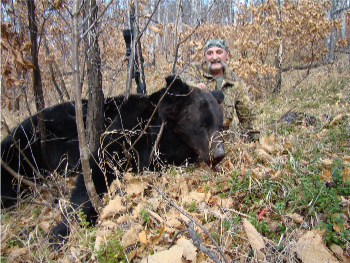
Location: Sovetsko-Gavansky district, Khabarovsk Krai
Season dates: September 10 – October 30
Hunting method: Spot and stalk
Accommodations: Remote cabin with an electric generator, satellite phone, sauna
Price: $9,000 group of 2; 9,800 solo
Additional trophies: Manchurian wapiti $3000
Included in the price:
Reception and assistance in Khabarovsk airport; Accommodation in the hunting area; Meals and soft drinks during the hunt; Transportation during the hunt; Services of 1 guide per hunter; Services of 1 interpreter in a camp; Field trophy preparation; Gun permit; Invitation letter and voucher; Hunting license; Trophy export permit; 1 bear.
Not included in the price:
Insurance of any kind; International and domestic airfare; Hotel in Khabarovsk before or after the hunt; Conservation, shipping or transporting trophies from Russia; CITES permit; Cost of sightseeing tours; Gratuities.
Itinerary:
Day 1: arrival to Khabarovsk, overnight in Khabarovsk
Day 2: 10-12 hour drive to the hunting area
Day 3-9: 7 days of hunting
Day 10: return to Khabarovsk, overnight in Khabarovsk
Day 11: flight home
Details:
This spot and stock hunt take place in Siberian pine and oak forests and along small streams during the keta salmon spawning period, where bears congregate in very large numbers to fatten up on ripening pine nuts, acorn, and fish. Finding bears at this time of the year is easy and most hunters take their trophies. This hunt is suitable for archery hunters.
Request Information:
Sergei Shushunov and his Russian Hunting LLC offer the best bear hunting in all Russian regions, including the European North-West of Russia in St. Petersburg, Karelia, Novgorod, and Tver region, in Central and Southern Siberia, including Altai, Tuva, and Irkutsk regions, along the Pacific coast – Kamchatka, Magadan, Okhotsk, and the Caucasus Mountains. As a rule, the size of brown bears in Eurasia increases incrementally from west to east. The smallest animals, as measured by skull size and hide surface, are found in central European countries such as Slovakia and the largest along the Pacific coast of Russia.
The size of the trophies found in the European parts of Rusia and Siberia is similar to the size of grizzlies. The trophies found in Kamchatka and Magadan rival in size Kodiak island bears. The highest density of brown bear population is located on the Pacific coast and the European parts of the country.
A large number of brown bears in Russia make hunting very productive. The success rate on guided brown and grizzly bear hunts in Alaska or Canada is about 30%. In contrast, in many areas in Russia, it is over 90%, and in some areas, the high density of the animals allows hunters to take home more than one trophy. With lower prices than bear hunts in the US and Canada and a success rate three times higher, Russian brown bear hunts are a lot more cost-effective and a lot less likely to end in disappointment. It’s unusual for a hunter to return home from a hunt in Russia without a trophy.
Brown bear subspecies in Russia
Russia is home to several subspecies of brown bears found in different parts of the country and our hunting methods depend on each type of bear’s preferred food source, which varies from region to region. For many years Russia allowed den hunting, but this was closed in 2012 (to the great disappointment of many thrill-seeking hunters).
Eurasian brown bear
This hunt is conducted in the regions of St. Petersburg, Novgorod, Vologda, and Karelia. In the European part of the country, these bears usually feed on wild berries, cultivated oats and barley, insects, small mammals, and carrion. The largest European bear ever taken by one of our clients weighed in at 360 kg. (790 lbs.), with a hide measuring 260 cm long (almost 9 ft.). The success rate of our Eurasian brown bear hunts is well over 90%.
The majority of the hunts are conducted from high stands over bait. The spring hunting season lasts only a couple of weeks in late April and May. We offer hunts over meat bait in Karelia from April 20-25 until May 20. The fall season usually starts on August 15 and ends around October 30. Early fall hunts are done from high stands alongside oat and barley fields. By the middle of September, oats become too dry and the bears switch their diet to wild berries. Bears enjoy eating wild berries so much that bating them is useless. The only way to hunt in September and most of October is by stalking. The only problem is that in the flat and heavily forested terrain of this part of Russia, spotting bears in the forest becomes a nearly impossible fit. Later in October, just before denning, bears can be bated by carrion. All methods of hunting European brown bears offer the hunter a truly thrilling experience, both on account of the environment in which the hunts take place and the opportunity to see these enormous and elegant creatures firsthand and up close in their natural habitat.
For a first-person account of what it feels like to hunt a European brown bear in fall, this article by Mark Hoffman, originally printed in Outdoor Edge, offers a small taste that’s sure to whet your appetite!
Siberian brown bear
The Siberian brown bear is, on average, larger than the Eurasian cousin. The most important food source for the Siberian brown bear during the summer and fall is pine nuts, which they consume in huge quantities in order to accumulate enough fat to see them through their winter hibernation. When the crop of pine nuts is inadequate, hunger makes bears very aggressive. This is when they start killing not only wild but also domestic mammals and often attack people. Siberian Brown Bear hunts are available in both spring and fall. Spring hunts usually involve stalking and glassing over the hillsides. In the fall, bears are hunted by stalking and baiting, and occasionally with dogs. Hunting in Siberia for bears offers to hunt for additional trophies, such as moose, wild boar, and wolverine.
Far Eastern brown bear
This bear, also known as the Kamchatka brown bear is found on the Kamchatka peninsula, Sakhalin island, and the shores of the Sea of Okhotsk – Magadan region and is amongst the largest bears there and perhaps even the world. These salmon-eating bears rival the bears of Alaska and Kodiak Island both in size and in the density of the population. (To give you an idea of what to expect, the largest Kamchatka brown bear skull on record was measured at 30 and 11/16 inches.) The prices of these Russian bear hunts are substantially lower than those in Alaska and the success rate is on average much higher owing to the density of the Far Eastern brown bear population where our hunts take place.
Kamchatka has become the number one destination for bear hunters in that region, although many hunters do not realize that the less frequently hunted areas of the Russian Northern Pacific Coast offer as good, or perhaps an even better chance of getting a very large bear. Seasons in May or June, for example, the density of bears along the shoreline of the Sea of Okhotsk can be so high that from a viewing point on a hill a hunter may be able to spot 30 to 50 bears at the same time. The spring season is the most productive for hunting the Far Eastern Brown Bear. At this time, bears emerge from hibernation and actively look for food while there is still snow cover on the ground, thereby making themselves visible from greater distances to hunters. The season starts at the end of April and ends at the end of May in the northern parts of Russia’s Pacific regions. Spring hunts in the southern parts of the Sea of Okhotsk start in late May and end in early June. During the fall season, we can combine bear hunt with moose and bighorn sheep.
Amur brown bear
The Amur brown bear is found in the southern parts of far eastern Russia. This bear has a darker than usual hide and is medium to large in size. It is considered to be similar to the bears found on Hokkaido Island in Japan. The hunt is offered in the Khabarovsk Krai and the Primorsky Krai of Russia over bait in the spring and spot and stock, or over bait in the fall.
Archery brown bear hunting
We offer brown bear hunts with bow and arrow in several locations. Please contact us to discuss different options.
Map of brown bears distribution in Russia
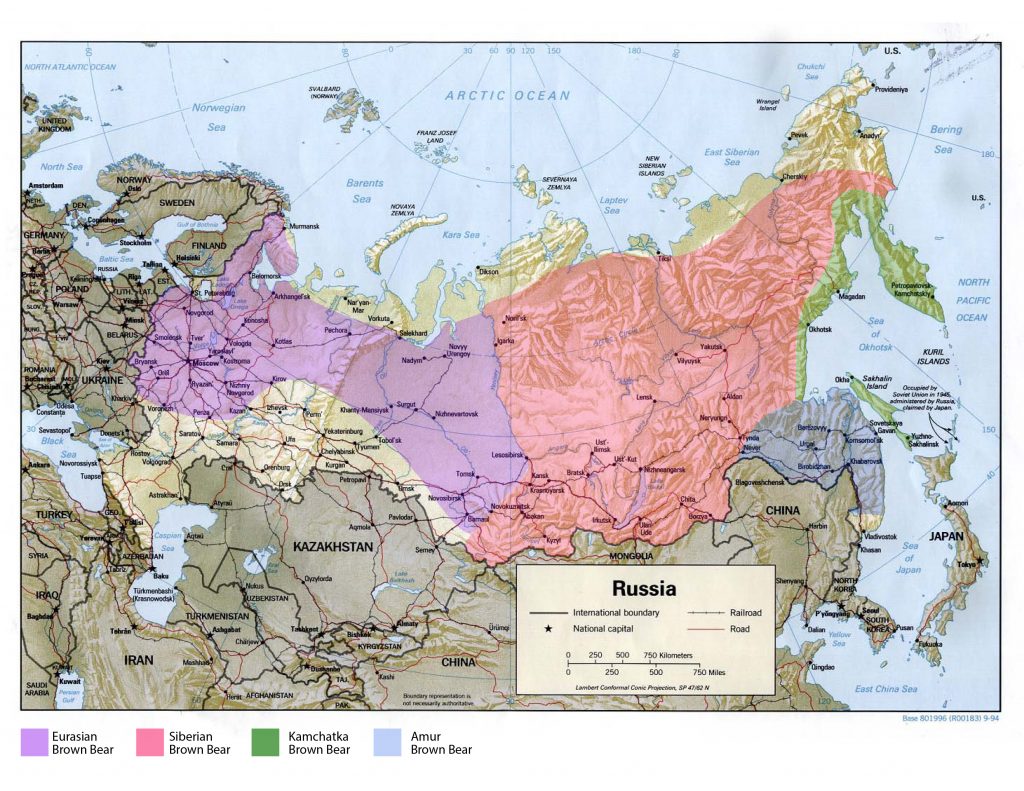
To see for yourself the type of trophies you can expect to take home from one of our hunts, please take a look at our trophy gallery, where you will find pictures of each of the above species and the happy clients who claimed them as their trophy!
Q & A
Where to go bear hunting?
Russia has the larges brown bear population in the world spread over 10 time zones. This means that bears can be hunted almost anywhere. However, Russia has two large geographic areas where bear hunting is the best and the most productive due to the high density of the bear population. European North West, including St. Petersburg, Novgorod, Pskov, Karelia, Vologda, Arkhangelsk, and Tver regions, and Russian Far East, including Chukotka, Kamchatka, Magadan, Khabarovsk, Primorsky rai and Sakhalin island.
When is bear hunting season in Russia?
Russia has two bear hunting seasons: spring and fall. Spring season starts around the time bears emerge from hibernation, which happens between the end of April and early May and lasts, depending on location, until the second half of May to early June. The fall hunting season starts in August and officially ends in late October, however, past September bear hunting usually becomes much less productive.
What to wear for bear hunting?
The selection of clothes for bear hunting depends on the season, hunting method, and location. In the European northwest of a bear is usually hunted by baiting. This type of hunting requires wearing clothes made from silent fabrics. The insulation layer can be added if needed. The weather during Spring hunts in the Far East of Russia is often moderately cold and dry, requiring warm clothes. During the fall season in the Far East of Russia, rains are common, therefore hunters should bring waterproofed clothes and be prepared for a sudden drop of temperature in the late season. Hunting in Kamchatka is an unforgettable trip!
What caliber rifle is good for brown bear hunting?
The choice of caliber depends on the bear size. Bears in the European part of Russia are on average smaller than in Siberia and Siberian bears are on average smaller than Far Eastern bears. The minimum recommended caliber for a European bear is 30-06 and similar. The minimum recommended caliber for Far Eastern brown bear is 300 Win mag. If you want to choose a caliber good for all bear subspecies found in Russia, I advise 300 WSM, 325 WSM, 300 Win mag, 35 Whelen, 338 Lapua mag., and similar.
How to go bear hunting?
Choose your location. Eurasian bear hunts are significantly less expensive than, for example, Far Eastern bear hunts. Flying to the European part of Russia is usually less expensive than flying to Siberia or the Far East. The physical demands of hunting are substantially higher during the fall season in Siberia and the Far East. The least physically demanding are bated hunts, which are impractical in many parts of region but are often used hunting Eurasian brown bear and amur brown bear. Choose your dates. Once you determined when and where you want to hunt, make a reservation, which requires filling out a booking form and making a deposit. After this make a list of necessary equipment and obtain a tourist visa for traveling to Russia.
Reviews:
From the moment we sent the 1st email to Sergey everything was really well run and efficient from the itinerary/all the letters for the Russian entry visas for us and our hunting rifles. The accommodation was a brand new hunting lodge (4 twin bedrooms shower/bathrooms etc with lounge and kitchen on the ground floor). Very comfortable. Read more

